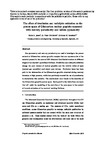The effect of irradiation and radiolytic oxidation on the porous space of Gilsocarbon nuclear graphite measured with mercury porosimetry and helium pycnometry
| dc.contributor.author | Jones, Katie Louise | |
| dc.contributor.author | Matthews, Peter | |
| dc.contributor.author | Laudone, Giuliano Maurizio | |
| dc.date.accessioned | 2019-12-17T12:33:36Z | |
| dc.date.available | 2019-12-17T12:33:36Z | |
| dc.date.issued | 2020-03 | |
| dc.identifier.issn | 0008-6223 | |
| dc.identifier.issn | 1873-3891 | |
| dc.identifier.uri | http://hdl.handle.net/10026.1/15255 | |
| dc.description.abstract |
Gas pycnometry and mercury porosimetry are used to investigate the porous network of Gilsocarbon nuclear graphite samples that are representative of the material present in the cores of UK Advanced Gas-Cooled reactors at different stages of the reactors’ operational lifetimes. Irradiation and radiolytic oxidation change the pore volume of nuclear graphite and the relative ratios of open (coolant gas accessible) and closed pore volume. Particular focus has been paid to the deformation of the Gilsocarbon graphite observed during mercury intrusion at high pressure, which has previously marred the use of porosimetry to characterise this material. The results show clear trends in the evolution of the Gilsocarbon graphite porous space. Semi-quantitative deductions are made that will assist the modelling of the evolution of the pore space in the context of the safe extension of the reactors’ working lifetimes. | |
| dc.format.extent | 256-266 | |
| dc.language | en | |
| dc.language.iso | en | |
| dc.publisher | Elsevier BV | |
| dc.title | The effect of irradiation and radiolytic oxidation on the porous space of Gilsocarbon nuclear graphite measured with mercury porosimetry and helium pycnometry | |
| dc.type | journal-article | |
| dc.type | Journal Article | |
| plymouth.author-url | https://www.webofscience.com/api/gateway?GWVersion=2&SrcApp=PARTNER_APP&SrcAuth=LinksAMR&KeyUT=WOS:000512995800027&DestLinkType=FullRecord&DestApp=ALL_WOS&UsrCustomerID=11bb513d99f797142bcfeffcc58ea008 | |
| plymouth.volume | 158 | |
| plymouth.publication-status | Published | |
| plymouth.journal | Carbon | |
| dc.identifier.doi | 10.1016/j.carbon.2019.11.084 | |
| plymouth.organisational-group | /Plymouth | |
| plymouth.organisational-group | /Plymouth/Faculty of Science and Engineering | |
| plymouth.organisational-group | /Plymouth/Faculty of Science and Engineering/School of Geography, Earth and Environmental Sciences | |
| plymouth.organisational-group | /Plymouth/REF 2021 Researchers by UoA | |
| plymouth.organisational-group | /Plymouth/REF 2021 Researchers by UoA/UoA07 Earth Systems and Environmental Sciences | |
| plymouth.organisational-group | /Plymouth/Users by role | |
| plymouth.organisational-group | /Plymouth/Users by role/Academics | |
| dcterms.dateAccepted | 2019-11-25 | |
| dc.rights.embargodate | 2020-12-8 | |
| dc.identifier.eissn | 1873-3891 | |
| dc.rights.embargoperiod | Not known | |
| rioxxterms.versionofrecord | 10.1016/j.carbon.2019.11.084 | |
| rioxxterms.licenseref.uri | http://www.rioxx.net/licenses/all-rights-reserved | |
| rioxxterms.licenseref.startdate | 2020-03 | |
| rioxxterms.type | Journal Article/Review |


